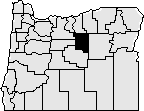
Wheeler County was established Feb. 17, 1899. Formed from parts of Grant, Gilliam, and Crook Counties, there have been no boundary changes since its creation. The county shares boundaries with Gilliam and Morrow Counties to the north, Wasco and Jefferson to the west, Crook to the south, and Grant to the east. The county was named for Henry Wheeler, who operated the first stage line through the county. The area of the county is 1,713 square miles.
The county seat is located in the city of Fossil. The town's name was derived from the first postmaster's discovery of fossil remains on his land in 1876. Fossil was designated the temporary county seat when the county was created. In 1900 there was an election to determine the permanent county seat. Spray, Twickenham and Fossil were the aspirants with Fossil winning the election. The current courthouse was built in 1902.
Wheeler County's government consists of a county court made up of a county judge and two commissioners. The county judge retains judicial authority for probate and juvenile proceedings. Other county officers include assessor, district attorney, justice of the peace, clerk, sheriff-emergency services director, treasurer, and surveyor.
Wheeler County's 2018 population was 1,450. This represented an increase of 0.6% from 2010. The county population has declined considerably since a peak of 3,313 occurring in 1950.
The terrain varies widely from sagebrush, juniper, and rim rock to thick stands of pine and fir. Portions of two national forests lie within its boundaries with forest lands covering nearly one third of the county. The area is known as an outstanding depository of prehistoric fossils. The Painted Hills and Clarno units of the John Day Fossil Beds National Monument are located in the county. Principal industries are agriculture, livestock, and recreation.